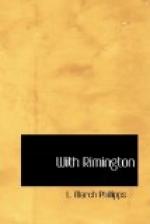R. and I rode eastward through the hills in the Golden Gate direction, meeting parties of Boers, waggons, Cape-carts, &c., coming straggling in. It reminded me of the road to Epsom on a Derby morning. There is some pleasure in meeting Boers on these terms. “Good morning. How are you? A pleasant morning for a ride, is it not?” “Good morning, sir; it is fine now, but I think we shall have rain later.” That’s what I like. There’s nothing like a little urbanity.
Towards the end of a long valley we come to some signs of defensive work that interest us. The Boers evidently expected to be able to await our advance here before they found their retreat was cut off. They have thrown up some shelters. We noticed from afar off several very conspicuous stone sangars, but coming close, we were surprised to find that they were made of stones loosely put together with big chinks, very flimsy and frail, and much too high for their purpose, too. They evidently were not intended for shelters at all. What were they there for? We looked carefully round, and at last the meaning of the device struck us. A hundred yards to the right the ground dropped sharp, leaving an edge; here was the real position and the natural cover. We walked over, and found the usual little hollows and inconspicuous stones arranged. Here was where their riflemen had lain, with a view right up the valley. And the meaning of those conspicuous edifices was now plain. Stuck up on the bare brow, plain to be seen at 2000 yards, they were simply meant to draw our fire. The smokeless Mausers would have told no tales, and I have no doubt that, if the attack had come off, the device would have more or less succeeded, for the stone shelters, though obviously dummies on close inspection, looked all right at a distance. Besides, a definite mark always attracts fire. It was characteristic of Boer cuteness.




